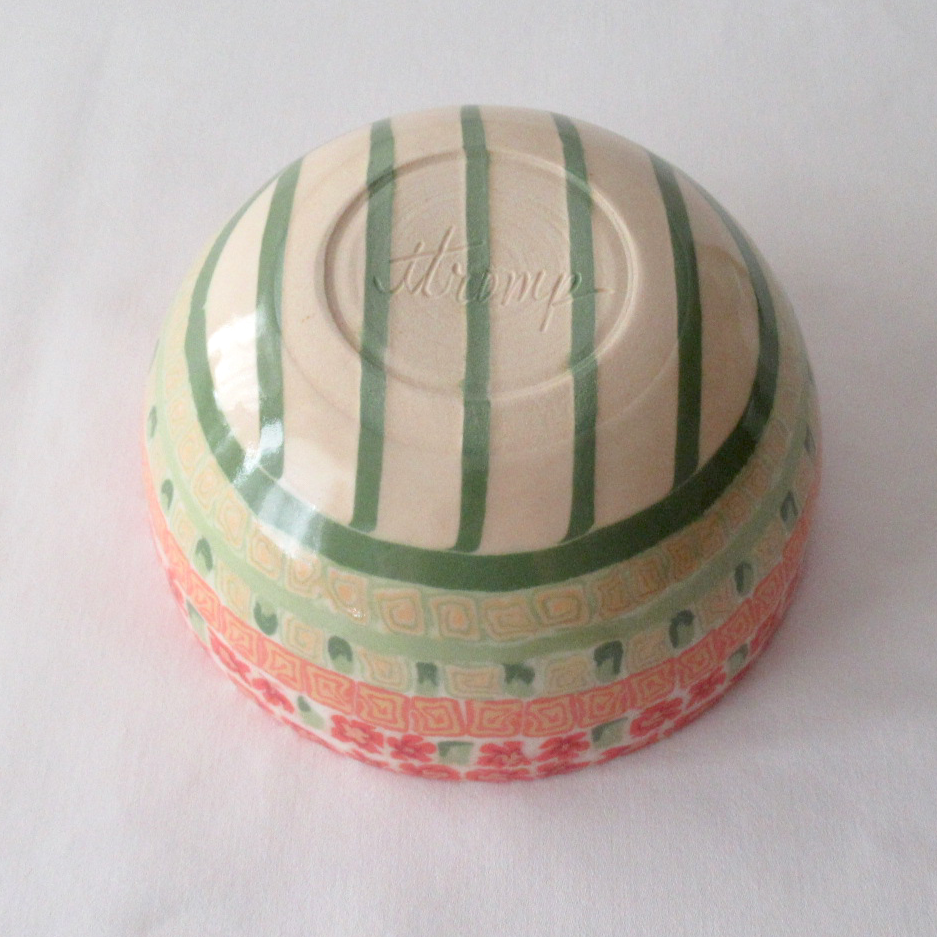Tromppottery
A Nerikomi Bowl. Small Red Flowers Colored Porcelain Technique. Ceramic Pottery.
A Nerikomi Bowl. Small Red Flowers Colored Porcelain Technique. Ceramic Pottery.
Couldn't load pickup availability
Small Red Flowers Press Molded Colorful Nerikomi Bowl
Measures:
4-5/8" wide x 2-1/4" high. ( 11.74cm x 5.71cm)
Holds approximately 1-1/2 cup (12 oz.)
Bright colored porcelain clay colors of red, orange, yellow, green and a neutral of ivory.
Ice cream bowl, dessert bowl, salsa bowl.
Decorative Nerikomi bowl.
This bowl was created using a porcelain press mold, which I made myself on the potter's wheel with porcelain clay.
Shallow footring on the bottom of this bowl was formed by placing the bowl upside down on the potter's wheel while in its raw (greenware) state, and trimmed for a footring.
Nerikomi is, in my opinion the most difficult colored porcelain technique. So, why am I so persistent in this endeavor?
When it works; when it is successful, (NO unmentionables - cracks) nerikomi has the most amazing look and smoothness to the surface.
The colors are bright and crisp, and the design appears on the inside, as well as the outside!
Glazes and/or underglazes can not produce the same effect.
The color is embedded into the clay; not on just the surface.
Standard 365 Porcelain Clay.
Fired to Cone 6 (2232ºF).
Glazed with dinnerware safe, lead free, glossy clear glaze.
Because of the delicate design, it would be best to hand wash this bowl.
I will probably always recommend hand washing my handmade pottery, even though they are technically dishwasher / microwave safe.
How it’s Made
Nerikomi - In Japanese, neri is a root word meaning "to mix". Komi means "to press into," as in pressing clay slabs into a mold.
Nerikomi thus means to hand-build with colored clay, as in mold work. It has been expanded to include other methods of hand-building."
This "Small Red Flower Nerikomi Bowl" begins with colored porcelain that I color myself.
Small millefiori flowers and murrine were formed into canes about 1-1/2" long.(Murrine are colored patterns or images made in a cane that are revealed when the cane is cut into thin cross-sections.
One familiar style is the flower shape.
The flower shape is called millefiori.)
Each small murrine and millefiori piece is laid into a bisqueware mold that I form on the potter's wheel from porcelain clay, then bisque fire (1945ºF). The sections are adhered together using porcelain slip. (wet, colored porcelain clay)
When the design is dry enough to be handled, it's pulled out of the mold and allowed to thoroughly dry under plastic.
The Nerikomi piece is sanded with 100 grit sandpaper, then 220 grit sandpaper.
The piece is signed and bisque fired, then sanded and/or wet sanded again, and into the kiln for its final firing. (2232ºF)
Nerikomi is labor intensive technique, and cracks can appear at any stage of creativity.
When Nerikomi pieces are successful, it is with great appreciation, and never do I take Nerikomi success for granted.
I am continually discovering new ways to produce successful Nerikomi pieces.
The look of a Nerikomi piece of pottery is so different from glazed ware, as the color is embedded into the clay; the design appears on both sides of the pottery piece.
Share








